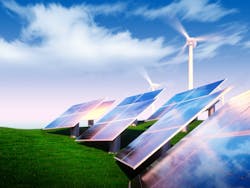Installation Completed of Record-size Hybrid Microgrid at Australia Mine
Sophie Vorrath of Renew Economy reports on the completion of the largest hybrid microgrid in Australia.
A groundbreaking 56-MW solar, wind and battery project built to power a gold mine in remote Western Australia has been completed, marking the largest hybrid microgrid of its kind in Australia and the first in the country to use wind-generated electricity to power a mine.
Global energy producer EDL said on Monday that it had successfully completed the project for Gold Fields’ Agnew Gold Mine, with all five wind turbines “up and running and successfully integrated” into the microgrid in W.A.’s northern goldfields region.
As well as the 18 MW of wind power, the ARENA-backed microgrid has a 4-MW solar farm, a 13-MW/4-MWh battery storage system and an off-grid 21-MW gas/diesel engine power plant, all controlled by an advanced microgrid system.
EDL said that, in favorable weather conditions, the project had proven capable of delivering up to 70% of Agnew’s power requirements with renewable energy.
On average, however, the microgrid is expected to supply around 50% of the gold mine’s electricity from renewables, through a 10-year power purchase agreement with EDL, who will act as owner-operator of the off-grid system.
“We applaud Gold Fields for their vision in embarking on this journey with us, and their role in leading the Australian mining industry’s transition to clean, reliable renewable energy,” said EDL CEO James Harman in a statement.
“We also acknowledge the incredible achievement of the EDL project delivery team and our contractors,” he added. “We faced transport challenges during the bushfires and impacts on personnel from Covid-19 restrictions as well as geographical, logistics and technical challenges to safely construct this innovative energy facility in the remote WA Goldfields region.”
Among these challenges was transporting the huge wind turbine parts in a 391-mile road trip from Port Hedland to the mine site — believed to be the longest such truck-trip for components of that size in the world, as One Step Off The Grid reported in December of last year.
Gold Fields executive vice president of Australasia, Stuart Mathews, said the completion of the project was an important milestone for Gold Fields — and the broader mining industry.
“We are proud to be able to showcase this project with EDL as an outstanding example of the capacity of the hybrid renewable energy model to meet the dynamic power requirements of remote mining operations,” he said.
“For our people and our stakeholders, this is a very clear demonstration of our commitment to reducing our carbon footprint whilst strengthening our security of supply. “Having built our internal technical capability and developed strong relationships with our business partners, we are well placed to continue to implement renewables solutions elsewhere in our business,” Mathews said.
An increasing number of mining companies are following suit.
In February, Oz Minerals explained in its results briefing why it had decided to go with a combination of wind, solar and battery storage — over gas — to provide at least 80% of the power needs of its proposed $1 billion nickel mine in a remote part of Central Australia.
Element25 meanwhile is also looking at up to 90% renewables to power its proposed Butcherbird manganese project that will include refining into manganese metal, a potentially groundbreaking leap into the “green metals” industry for Australian resource companies.
The Australian Renewable Energy Agency contributed $13.5 million in recoupable finance to the $112 million project.
This blog originated on Renew Economy and was reposted with permission. The author, Sophie Vorrath is editor of One Step Off The Grid and deputy editor of its sister site, Renew Economy.
Track news about hybrid microgrids by subcribing to the free Microgrid Knowledge newsletter.
